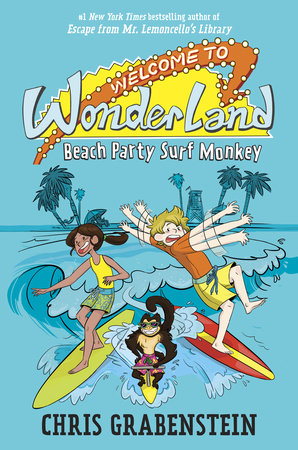Not Just for the Laughs: The Value of Comedy in Middle Grade Reads
by Chris Grabenstein
Okay, close your eyes and try to remember the last time you rode a roller coaster.
No, wait. Bad idea.
If you close your eyes, you won’t be able to read the rest of this post about mixing the scary with the funny, the thrillingly mysterious with the ridiculously hilarious, the yin with the yang.
Okay, back to the roller coaster. Keep your eyes open but use your imagination.
You’re climbing up the first very tall hill. The chain yanking you skyward clinks beneath your feet. Butterflies flutter in your stomach. You’re giddy, excited about what lies ahead. You are probably even giggling. Then your car clanks up to the very top of the hill.
And you plummet.
You’re terrified. While on the outside you might be all arms-up-over-your-head and squealing, inside your rational brain is screaming, “Why did I do this? Why, why, oh, why?”
Your stomach is somewhere behind your nose. G-forces make your cheeks flap. You wonder whether that corn dog and cotton candy were good ideas.
But then, a few seconds later, you bottom out. The car slows while you round a gentle curve. “That wasn’t so bad,” you think. You’re even giggling again.
But then there is another hill and more screams. “Nooooo!” Followed by another valley and more laughs. Followed by another hill and another valley. You’re screaming then laughing then screaming again.
When I talk to kids about writing, I often use the roller coaster metaphor to remind them to mix laughs with thrills, because nobody wants to ride a roller coaster that’s one long, never-ending, terrifying drop. Even Shakespeare, in his darkest tragedies, opens each act with a bit of buffoonery— a funny scene before the swords and daggers or poison vials come out. We need comic relief in literature, a break in the tension.

I have always tried to write stories for kids that mix the heart-racing thrill of a mystery with a few giggle-inducing jokes. Maybe this is because, when I was in the fifth and sixth grades, the satirical comic book Mad magazine was my favorite reading material. Then in high school, I was the class clown. When I first moved to New York City, I performed with The First Amendment, one of the city’s top improvisational comedy troupes. Comedy, I have discovered, is a great teaching tool. It is also a wonderful defense against fear.
One of my favorite e-mails I’ve ever received was sent to me in 2009 by a young reader who loved my Haunted Mystery ghost stories. Here’s what he wrote:
Dear Mr. Grabenstein,
I just wanted to let you know that I really, absolutely LOVE your books. I’m in 6th grade and recently finished The Hanging Hill after reading The Crossroads. Your stories intermix action, humor and horror together in a perfect blend (plus, they’re not overly scary, like some books…yeesh!!)
Thanks so much!
Will R.
Comedy is a writer’s tool for releasing tension, and it also simply makes books more fun to read. I used humor in my middle grade novel The Island Of Dr. Libris to make classic literature feel more accessible to young readers. I also think it’s why so many reluctant readers — including kids who haven’t read a book in years — have been gobbling up Escape from Mr. Lemoncello’s Library and its sequel Mr. Lemoncello’s Library Olympics. Learning your way around the Dewey decimal system can be fun if it is presented in a funny way. Because when we’re laughing, we never think we’re working too hard.
Besides, Mr. Lemoncello is pretty darn wacky. Here he is in Mr. Lemoncello’s Library Olympics, riding a giant dinosaur with extremely foul breath, thanks to his innovative “smell-o-vision” technology:
“Woo-weee!” cried Mr. Lemoncello, who, in a complete cowboy costume, was riding in a saddle strapped around the giant audio-animatronic Apatosaurus’s neck. “I knew the dinosaurs were extinct, but I didn’t know they were extra stinky, too.” He took in a deep breath. “Ah, isn’t smell-a-vision wondermous?” He unbuckled some sort of seat belt and hopped out of his saddle. “Thank you, Brontie,” he said to the big Apatosaurus. “By the way, I love your sister Charlotte. Now, please — go floss.”
When I look back on my own school days, the teachers I remember most are the ones who worked the classroom like stand-up comics. I recently gave my school presentation — in which I use improvisational comedy techniques to teach story structure — to a group that included my favorite teacher of all time: my ninth grade English teacher, who is still teaching today. When I was finished, my former teacher said, “Way to go, Grabber.” (Yes, that’s what everybody called me in high school.) “You put on the clown suit and had the kids laughing so much they didn’t realize they were learning something.”
And that’s why I will keep on writing roller coaster reads. It’s what my reader Will called the “perfect blend” of scary and funny, thrilling and amusing. It makes reading fun.
And, to paraphrase Mary Poppins, the more something is fun, the more of it gets done.
-
Books by Chris Grabenstein:
-
-








